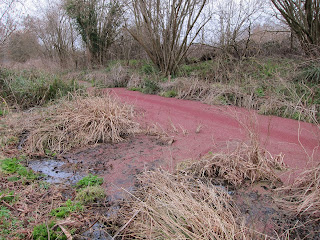 |
| Azolla filiculoides, March 2018 |
starfrostmoon
Life and the magic of the natural world.
12 July 2018
An Invading Plant
Early in March, I took a walk to Old Hall Copse at Woking Palace to see if the daffodils were in flower. They were indeed flowering and very beautiful. But then my companion asked "What's all that red over there?" I turned to look and knew the answer straight away, the Palace Moat had been invaded by the Fairy Fern also called Water Fern, Azolla filiculoides. This water plant turns bright red under environmental stress, it doesn't much like the cold and we'd had snow not long before.
28 October 2017
Making a Skep
A skep is a type of traditional beehive. This particular skep is being made from straw but other materials were, and still are, used by bee-keepers to make homes for their honey bees.
In October I was fortunate to attend a most enjoyable workshop at the National Honey Show where Mr. Chris Park of Acorn Education taught a small group of bee-keepers this ancient technique.
In October I was fortunate to attend a most enjoyable workshop at the National Honey Show where Mr. Chris Park of Acorn Education taught a small group of bee-keepers this ancient technique.
23 June 2017
A Wildlife Corridor - Footpath 99
"Can you look at Footpath 99? it's overgrown" the Residents Association's Footpath Officer (that's me) was asked. So, off I went to take a look. Footpath 99 turned out to be a small, rather unloved, right of way running between suburban back gardens....
21 February 2017
A Cloud of Yew Pollen
Walking near the churchyard I noticed an ancient yew tree was flowering.
When I shook a branch a cloud of pollen was released, and I found I was covered in pollen grains.
Yew pollen from Marion Malcher on Vimeo.
Early in the year honey bees require good sources of protein to feed the larvae in their expanding nests. Yew pollen is a valuable protein source although, along with other dry wind blown pollens, bees only use it when other sources are unavailable. The Yew tree does not yield nectar.
You may also like
The English Yew
When I shook a branch a cloud of pollen was released, and I found I was covered in pollen grains.
Yew pollen from Marion Malcher on Vimeo.
Early in the year honey bees require good sources of protein to feed the larvae in their expanding nests. Yew pollen is a valuable protein source although, along with other dry wind blown pollens, bees only use it when other sources are unavailable. The Yew tree does not yield nectar.
You may also like
The English Yew
13 August 2016
Honey Bee Flower Constancy
18 March 2016
Crossing paths with a Badger
Most people can identify a Badger, though many will never have seen a live one in the wild. But whilst you may not see Mr Brock himself you might find your paths cross more often than you'd think.
 |
| Badger (Meles meles) Photo: P.Trimming via Geograph |
14 February 2016
What's that in my garden mini pond? Newts and more.
2 November 2015
Prizewinning Honey & Beeswax at the National Honey Show 2015
I am really pleased to tell you that my honey and beeswax won prizes in the National Honey Show at the end of October. For the third year running I gained a 1st Prize for beeswax, winning the Silver Jubilee Bowl trophy, and this year, 2nd Prize for Naturally Crystallised Honey; in a class with honey from across the United Kingdom & Eire. The prizewinning honey was meadow flower honey from Woking.
 |
| National Honey Show - Honey 2015 |
 |
| National Honey Show - Beeswax 2015 |
1 October 2015
A visit to the home of Karl Von Frisch
Karl Von Frisch was the famous Austrian Nobel Prizewinner, who discovered how honeybees communicate by dancing.
29 September 2015
The Fire Salamander (Salamandra Salamandra)
18 September 2015
Honeydew Honey
The honey from some of my honeybee colonies this year is dark, rich, honeydew honey - and this is rather special!
5 September 2015
Wasp Spider - Argiope bruennichi
"What a beautiful spider!" those words may be a surprise, but take a look and you'll agree that the Wasp Spider is rather special. The bright yellow and black colouring of the female is distinctive and certainly "waspish". She is large (this one was about 5cm across), unmistakeable and with her long banded legs is rather a graceful spider too.
 |
| Wasp Spider ( Argiope bruennichi ) Photo M Malcher |
1 August 2015
Thistledown
White light gentle-soft
Thistledown blows by the oaks
Snow in summer-time
Thistledown from Marion Malcher on Vimeo.
Thistledown blows by the oaks
Snow in summer-time
Thistledown from Marion Malcher on Vimeo.
8 July 2015
Honey Flow
27 May 2015
A Swarm of Bees Lands
Do you know what a swarm of honey bees arriving looks like?
My doorbell rang. "There's a swarm of bees, come and get them!" Ok, just around the corner? "let's see then..." I went and looked. Yes, a lovely swarm of honey bees, about 12 metres (40 feet) up a Scots Pine tree...
My doorbell rang. "There's a swarm of bees, come and get them!" Ok, just around the corner? "let's see then..." I went and looked. Yes, a lovely swarm of honey bees, about 12 metres (40 feet) up a Scots Pine tree...
Subscribe to:
Comments (Atom)






